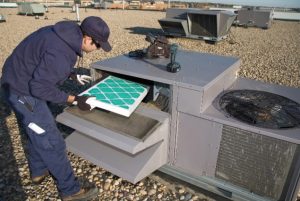— By Steve Peldiak —
Communal air solutions in retail and restaurant locations.
Sanitation conversations around indoor air quality (IAQ) at restaurants and retail locations will be critical to their longevity and bottom lines. 2021 has seen the arrival of a vaccine, however many customers may remain hesitant to dine or shop inside even with continued mask mandates.

Steve Peldiak, Watterson
Indoor air quality improvements completed and communicated to both employees and patrons will put many at ease as the path to public-wide vaccination is paved and businesses begin to fully reopen. “Now that the CDC has offered guidance on this topic, it will be harder for people to ignore the importance of ensuring good ventilation in buildings,” says Linsey Marr, Professor of Civil and Environmental Engineering at Virginia Tech. Stepping up health and safety strategies by improving IAQ can be done with a multi-layered approach.
HVAC maintenance, air filters and purifiers
- Stay up to date with your air filters by replacing them often and using the highest MERV rated filter for your system. Maintain the supply of adequate air flow to the spaces. Take precautions to minimize air flowing around the filters instead of through them.
- Check filters and housing to ensure they fit, are within service life, and that they are properly installed.
- Consider some of the latest technology and turn to air and surface “scrubbers.” They can practically eliminate all pathogens, viruses, bacteria and mold in the air and on surfaces. These new air purification devices turn oxygen and humidity from a room into super oxide ions and hydro peroxides, channeling the air into a cleaning agent.
- Improve the engineering controls using the building ventilation system. Consult with experienced heating, ventilating and air conditioning (HVAC) professionals before considering any of the following changes to HVAC systems and equipment.
– Increase total airflow supply to occupied spaces, whenever feasible.
– Increase outdoor air ventilation, using caution in highly polluted areas. With a lower occupancy level in the building, this increases the effective dilution ventilation per person.
– Disable demand-controlled ventilation (DCV) controls that reduce air supply based on occupancy or temperature during occupied hours.
- Consider running the HVAC system at maximum outside airflow for 2 hours before and after occupied times.
- Open all outdoor air intakes that are closed and regularly inspect outdoor air intakes. Adjust or repair improperly working intakes. Minimum outdoor air flow recommended by ASHRAE should always be provided to each space.
- Regularly inspect building exhaust fans to make sure all are working properly. Exhaust fans that are not functioning correctly can result in sub-optimal pressure differences throughout the building and can heighten IAQ problems.
- Begin the HVAC system earlier in the day before employees arrive to reduce temperature fluctuations and control humidity levels.
Clean equipment, floors, walls and surfaces
 Clean them thoroughly to reduce and avert dust, random particles and other debris from entering the restaurant’s or retail location’s HVAC system. Use cleaning products that are free from volatile organic compounds (VOCs). VOCs can pollute indoor air. Check how cleaning products and sanitation precautions are impacting the air quality. Volatile organic compounds can be found in cleaning products, which are being used more than ever these days. Keeping buildings extra-clean during the pandemic is a priority; however, please pay close attention to the levels of compounds that are entering the air. Infesting customers with VOCs while trying to keep them healthy from the virus is counterproductive.
Clean them thoroughly to reduce and avert dust, random particles and other debris from entering the restaurant’s or retail location’s HVAC system. Use cleaning products that are free from volatile organic compounds (VOCs). VOCs can pollute indoor air. Check how cleaning products and sanitation precautions are impacting the air quality. Volatile organic compounds can be found in cleaning products, which are being used more than ever these days. Keeping buildings extra-clean during the pandemic is a priority; however, please pay close attention to the levels of compounds that are entering the air. Infesting customers with VOCs while trying to keep them healthy from the virus is counterproductive.
- Inspect the internal exhaust fans and hoods to ensure all are working properly. The HVAC system can steadily circulate odors and potentially harmful vapor contaminants throughout the entire space.
Consider all the different types of HVAC sensors now available that go beyond just the thermostat
 Sensors are used to keep equipment running smoothly, safely and to improve energy efficiency. Sensors that measure indoor air quality are becoming increasingly important and drive better HVAC decisions with the data they can provide. A few key sensors to delve into further with a chosen service partner are listed below.
Sensors are used to keep equipment running smoothly, safely and to improve energy efficiency. Sensors that measure indoor air quality are becoming increasingly important and drive better HVAC decisions with the data they can provide. A few key sensors to delve into further with a chosen service partner are listed below.
- Carbon sensors
- Carbon dioxide sensors
- VOC sensors
- Pressure sensors
- Duct smoke detectors
- Occupancy sensors
- Gateway technology and sensors
Recognize the impact ergonomics may have on improving IAQ within a redesigned restaurant or retail space
Adapting workflow processes, identifying safety hazards and revisions to protocols will enhance indoor air quality.
Always follow CDC guidelines and do not forget to include an inspection of all the water systems
- Minimize the risk of water associated diseases such as Legionnaires’ disease. Take steps to ensure that all water systems and spouts are safe to use.
IAQ industry experts who have been highlighting the effects of indoor air contaminants and pathogens for years, this multilayered approach is enthusiastically welcomed. The focus on improving IAQ will also likely have benefits long after the coronavirus pandemic is over. Find an experienced and knowledgeable service partner to implement and guide you through the choices and guidelines. Instituting proper measures to assist in the health and safety of your customers and valued personnel will be key to a successful 2021.
— Steve Peldiak is president of Watterson, a national provider of facilities maintenance, emergency response and environmental services supporting over 60,000 commercial properties.

